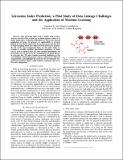Files in this item
Glycaemic index prediction : a pilot study of data linkage challenges and the application of machine learning
Item metadata
| dc.contributor.author | Li, Jingyuan | |
| dc.contributor.author | Arandelovic, Ognjen | |
| dc.date.accessioned | 2017-03-22T12:32:27Z | |
| dc.date.available | 2017-03-22T12:32:27Z | |
| dc.date.issued | 2017-02-18 | |
| dc.identifier | 249318627 | |
| dc.identifier | f2dc9f46-b29e-4277-8cce-827ff019a0f2 | |
| dc.identifier | 85018428202 | |
| dc.identifier | 000403312900089 | |
| dc.identifier.citation | Li , J & Arandelovic , O 2017 , Glycaemic index prediction : a pilot study of data linkage challenges and the application of machine learning . in 2017 IEEE-EMBS International Conference on Biomedical and Health Informatics (BHI) . , 7897279 , IEEE , pp. 357-360 , BHI-2017 International Conference on Biomedical and Health Informatics , Orlando , Florida , United States , 16/02/17 . https://doi.org/10.1109/BHI.2017.7897279 | en |
| dc.identifier.citation | conference | en |
| dc.identifier.isbn | 9781509041794 | |
| dc.identifier.isbn | 9781509041800 | |
| dc.identifier.other | ORCID: /0000-0002-9314-194X/work/164896007 | |
| dc.identifier.uri | https://hdl.handle.net/10023/10504 | |
| dc.description.abstract | The glycaemic index (GI) is widely used to characterize the effect that a food has on blood glucose which is of major importance to diabetic individuals as well as the general population at large. At present, its applicability is severely limited by the labour involved in its measurement and the lack of understanding about how different foods interact to produce the GI of the meal comprising them. In this pilot study we examine if readily available biochemical properties of food scan be used to predict their GI, thus opening possibilities for practicable use of the GI in the management of blood glucose in everyday life. We also examine practical challenges in the cross-linking of food information sources collected by different organizations, and highlight the need for the development of a universal standard which would facilitate automatic and error free data integration. | |
| dc.format.extent | 298712 | |
| dc.language.iso | eng | |
| dc.publisher | IEEE | |
| dc.relation.ispartof | 2017 IEEE-EMBS International Conference on Biomedical and Health Informatics (BHI) | en |
| dc.rights | © 2017, IEEE. This work has been made available online in accordance with the publisher’s policies. This is the author created, accepted version manuscript following peer review and may differ slightly from the final published version. The final published version of this work is available at ieeexplore.ieee.org / https://doi.org/10.1109/BHI.2017.7897279 | en |
| dc.subject | QA75 Electronic computers. Computer science | en |
| dc.subject | RC Internal medicine | en |
| dc.subject | NS | en |
| dc.subject | SDG 3 - Good Health and Well-being | en |
| dc.subject.lcc | QA75 | en |
| dc.subject.lcc | RC | en |
| dc.title | Glycaemic index prediction : a pilot study of data linkage challenges and the application of machine learning | en |
| dc.type | Conference item | en |
| dc.contributor.institution | University of St Andrews.School of Computer Science | en |
| dc.identifier.doi | 10.1109/BHI.2017.7897279 |
This item appears in the following Collection(s)
Items in the St Andrews Research Repository are protected by copyright, with all rights reserved, unless otherwise indicated.

